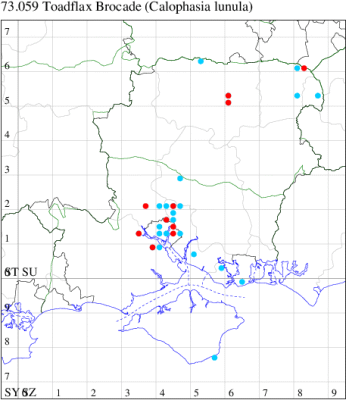2021 Annual Report for: Noctuidae / Oncocnemidinae
For species seen in 2021 that had less than or equal to 100 records, full details are included; for more common species, the earliest, latest and highest count by vice-county are shown. The narrative for each species is taken from the main Hantsmoths website, and it is possible that some information on abundance and occurrence can get out of date, as it is impossible to keep up with all changes; however it should give a good introduction to each species. The tables in each species account summarise the previous status, and that for the current year.
For the maps, all records prior to 2021 are shown by a blue dot (the larger the dot, the more recent), with the current year's records shown in red. As previous records are superimposed on any report for 2021, new sites have greater emphasis (i.e. will show as 'more red').
In the species accounts, an asterisk next to a location indicates a new 10km square record; earliest ever dates are highlighted in orange, and latest ever in red. Initials in the species accounts refer to the recorders listed here. Please get in touch if you identify any omissions or errors, in particular if you have records that have yet to be submitted. Details of how to submit records can be found here.
73.059 [B&F: 2223] Toadflax Brocade Calophasia lunula (Hufnagel, 1766) - RDB3
Previously a rare and local resident on shingle beaches and grassy areas in parts of south-eastern England, predominantly coastal; in Kent it occurs at Dungeness and along the coast to Folkestone, including records from Hythe, Dover and Kingsdown. In Sussex, larvae can be common on shingle beaches and waste places within a mile of the sea-shore. Prior to 2000, there were just three records, all coastal: the first at Locks Heath in 1971, with one at Southsea in August 1992 and one in Gosport in August 1996. However, the 21st Century has seen an expansion of range inland, from a base apparently in Greater London and since 2015 it has been recorded annually, both along the coast and from the north-east. The first Isle of Wight record was also in 2015. Wingspan 32-34 mm. Larva feeds on Purple Toadflax and Common Toadflax, over-wintering as a pupa.
Update: Status review, January 2020.
Records prior to 2021
| Vice County | #Records | #Individuals | First Record | Last Record |
|---|---|---|---|---|
| 10 | 1 | 1 | 2015 | 2015 |
| 11 | 32 | 29 | 1951 | 2020 |
| 12 | 14 | 20 | 2017 | 2020 |
2021 records
| Vice County | #Records | #Individuals | Max Quantity |
|---|---|---|---|
| 11 | 23 | 29 | 4 |
| 12 | 6 | 13 | 8 |

Records by year
Records by week (adult)
Records by week (larval)
Record Details
VC11: Marchwood*, one, 02 Jun; one, 19 Aug; one, 31 Aug (CTha); Totton*, one, field observation, 05 Aug (SSto); one, 30 May; one, 31 May; one, 09 Jun; one, 10 Jun; one, 16 Jul; one, 13 Aug; one, 18 Aug; one, 25 Aug; one, 27 Aug; one, 28 Aug; one, 29 Aug; one, 30 Aug (LHan); Romsey, one, 06 Jun (MBak); Swaythling, Southampton, two, 11 Jun; one, 16 Aug (MEdg); Southampton, one, 16 Aug (MGP); Bitterne, Southampton, larva, four, on host-plant, 07 Jul (DWal det. KJW); Bitterne, larva, three, field observation, 20 Sep (NBur); Allbrook, one, 26 Aug (SIng);
VC12: Basingstoke, one, 06 Jun; one, 03 Aug (MJW); one, 01 Jun; one, 18 Jul (RHil); Frogmore, larva, one, field observation, observed forming pupae on fence, 08 Jul; pupa, eight, field observation, 08 Jul (BDal)
.jpg)